Florida’s Stunning White Birds – Explore Their Beauty
Updated: 12 Mar 2024
51

Florida is a hot spot for tourists, attracting over 125 million visitors every year with its stunning beaches and exciting attractions. But for birdwatchers, Florida is also a paradise. Its nice weather, plenty of water, and lush plants provide homes for thousands of bird species. Whether you’re exploring marshes, swamps, lakes, or the coastline, you’ll find birds that can thrive in both freshwater and saltwater environments.
This article delves into some of the white birds found in Florida, providing insights into their habitats, diets, and distribution across the state. Keep reading to discover more about these fascinating avian inhabitants!
Here is a list we’re going to discuss in this blog post:
Florida’s Year-Round White Birds:
In Florida, you’ll find a variety of stunning white birds. Eight of these species are year-round residents found throughout the state, while the other three typically migrate during the winter months. If you’re hoping to spot some beautiful birds with pearly-white plumage this year, keep an eye out for the following:
1. White Ibis:

- Scientific Name: Eudocimus albus
- Average Weight: 1.924 – 2.780 lb
- Wingspan: 35 – 41 inches
- Lifespan: 16 years
- Appearance: White body, black-tipped beak, reddish-pink bill, and legs.
- Diet: Crayfish, crabs, insects, small fish.
- Conservation Status: Least concern
- The best time to see them in Florida: All year long
The White Ibis is a common bird in Florida. They like to hang out in groups and can be found in various habitats, like marshes and shallow waters. You can easily recognize them by their long legs and curved, red bills.
They have white feathers with black tips on their wings if they’re adults, while young ones have brownish feathers and orangish-pink legs.
These birds mainly eat crabs, crayfish, and other small creatures they find in the mud. Sometimes they’ll snack on insects, fish, or frogs too.
You might see them wandering around parks or wetlands, poking their bills into the ground to find food. They’re pretty friendly and easy to spot with their bright red legs and beaks.
2. Great Egret:

- Scientific Name: Ardea alba
- Average Weight: 1.5 – 3.3 lb
- Wingspan: 52 – 67 inches
- Lifespan: 5 years
- Appearance: Rounded bills, long legs, White body, S-shaped neck,
- Diet: Fish and frogs
- Conservation Status: Least concern
- The best time to see them in Florida: March and April
The Great Egret is a magnificent sight across Florida. It’s a long-legged wading bird with a slender, S-shaped neck and a dagger-like bill. With an all-white body and a yellowish-orange bill, it extends its legs beyond its tiny tail during flight.
Smaller than the Great Blue Heron, the Great Egret has a remarkable wingspan. It hunts by standing still or wading through wetlands to catch fish with its sharp bill.
Preferring shallow waters, it primarily feeds on small aquatic animals like frogs, often catching prey by surprise. Once it spots its prey, it strikes with incredible speed, using its bill to crush its catch.
Great Egrets were nearly hunted to extinction in the late nineteenth century due to demand for their plumes. This led to the establishment of conservation movements and some of the earliest laws to protect birds.
These birds nest in colonies, usually high in trees or on islands without predators. You can find them in both saltwater and freshwater habitats.
3. Wood Stork:

- Scientific Name: Mycteria americana
- Average Weight: 5.5–7.3 lb
- Wingspan: 55 – 71 inches
- Lifespan: 11 – 18 years
- Appearance: Bulky profile, long bill, White body, black wingtips,
- Diet: Fish and crustaceans
- Conservation Status: Least concern
- The best time to see them in Florida: All year long
The Wood Stork is a remarkable wading bird found in Florida. It’s known for its impressive flying ability, soaring with outstretched legs and neck. Towering just beyond 3 feet tall, it has a bald head and a hefty, elongated bill used to feed on crustaceans and fish.
With a bulky, football-shaped profile, the Wood Stork has a distinct appearance, characterized by white body plumage with black wingtips. Its head is scaly-looking and unfeathered, and it often roosts in colonies in trees above standing water.
Resembling the size of the Great Blue Heron, the Wood Stork is commonly found in wetlands, especially in catfish ponds and flooded swamps. It forages in marshes with an open canopy and often feeds in groups, moving in lines one after the other.
4. Cattle Egret:
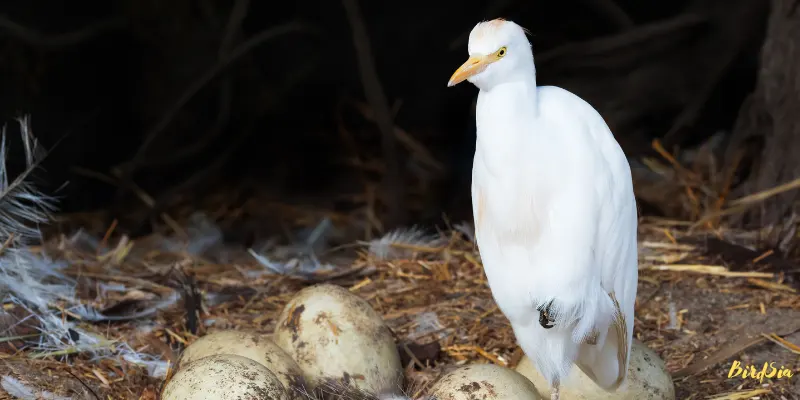
- Scientific Name: Bubulcus ibis
- Average Weight: 0.59 – 1.13 lb
- Wingspan: 35 – 38 inches
- Lifespan: 10 years
- Appearance: Stout yellowish bill, rounded wings, compact, thick neck.
- Diet: Insects, flies, crickets, and earthworms.
- Conservation Status: Least concern
- The best time to see them in Florida: All year long
The Cattle Egret, also known as Bubulcus ibis, is smaller than most herons. It has short legs, a thick neck, and medium-length, rounded wings. Its bill stands out, being thicker and more dagger-like, with a bright yellow color matching its legs.
During breeding, you’ll notice golden plumes on the head, back, and chest of the Cattle Egret. Juveniles have a darker bill and legs. They often search for food in groups in fields and pastures, preferring drier habitats. While hunting, they bob their heads or hitch rides on larger animals to catch prey.
Originally from Africa, Cattle Egrets came to North America in 1953 and spread rapidly. They’re often seen foraging near large animals like rhinos and camels. They nest in dense colonies in wetlands or trees with other herons. Their diet mainly consists of insects, flies, crickets, and earthworms, which help control pests in fields.
5. Snowy Egret:
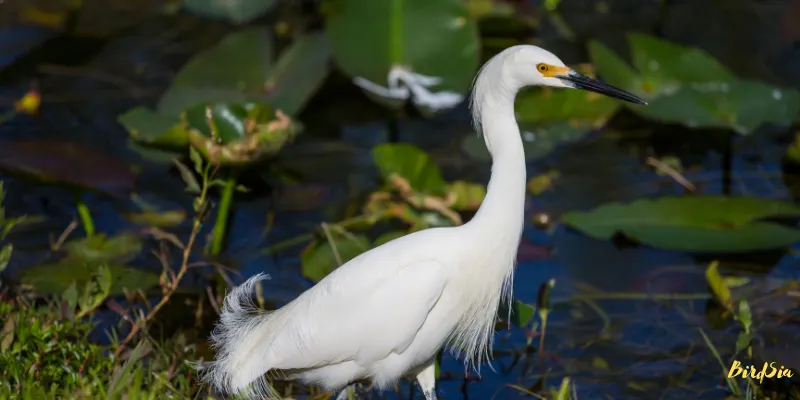
- Scientific Name: Egretta thula
- Average Weight: 0.81 lb
- Wingspan: 39.4 inches
- Lifespan: Up to 16 years
- Appearance: yellow feet, blackish legs, with a yellow patch under the bill, slender body, entirely white plumage,
- Diet: Primarily aquatic animals.
- Conservation Status: Least concern
- The best time to see them in Florida: All year long.
The Snowy Egret is a graceful heron found throughout Florida. It sports a striking all-white plumage with vibrant yellow feet and black legs, making it easily distinguishable. During the breeding season, it develops elegant plumes, which were once highly valued in the fashion industry, leading to conservation efforts in the early 20th century.
This medium-sized heron hunts actively for aquatic animals, employing both a sit-and-wait strategy and active chasing. You’ll often hear its raucous call near nesting colonies. Snowy Egrets can be spotted in wetlands, mudflats, and along the coast, especially in protected areas. They are a common sight year-round in Florida.
6. Juvenile Little Blue Heron:
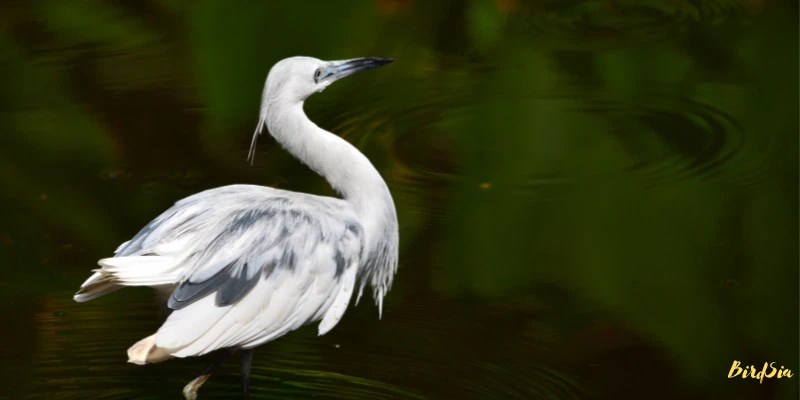
- Scientific Name: Egretta caerulea
- Average Weight: 0.71 lb
- Wingspan: 40 inches
- Lifespan: Up to 7 years
- Appearance: Spearlike bill, rounded wings, two-toned beak, all-white body, slender neck, elongated legs.
- Diet: Fish, crustaceans, amphibians, and insects.
- Conservation Status: Least concern
- The best times to see them in Florida: September and October
The Juvenile Little Blue Heron is a small-sized bird with a slender neck and elongated legs. Despite its name, it appears all-white when young, closely resembling the Snowy Egret. However, as it matures, it molts into a deeper blue shade.
This species employs a stand-and-wait technique to hunt for small fish and morsels. It usually nests in colonies with other herons and wading birds. While foraging, it carefully watches the water and changes locations by wading or flying to different spots.
Juvenile Little Blue Herons can be found in various wetland habitats, such as estuaries, tidal flats, swamps, and streams. They may also hide in secluded corners, so a keen eye and binoculars help spot them.
7. Great White Heron (White Morph):

- Scientific Name: Ardea herodias
- Average Weight: 4.0 – 7.9 lb
- Wingspan: 66 – 79 inches
- Lifespan: Up to 15 years
- Appearance: Vibrant yellow bill, shaggy feathers on the breast, all-white body, pale yellow legs.
- Diet: Fish and insects
- Conservation Status: Least concern
- The best time to see them in Florida: November – February
The Great White Heron closely resembles the Great Egret with its pearly plumage. Originally thought to be a white morph of the Great Blue Heron, recent studies suggest it may be a subspecies. Found mainly in the southern regions of Florida, it is sometimes mistaken for the Great Egret.
Distinctive features of the Great White Heron include its hefty size, heavy yellow bill, and shaggy feathers on the breast. While its body is predominantly white, its legs have a pale, dusky greyish-yellow color.
This species prefers habitats such as saltwater areas, tidal shallows, mangroves, and coastal ponds. It tends to be solitary, moving slowly and deliberately as it hunts for prey.
8. Roseate Spoonbill:

- Scientific Name: Platalea ajaja
- Average Weight: 2.6–4.4 lb
- Wingspan: 50–53 inches
- Lifespan: Up to 15 years
- Appearance: Distinctive pink plumage, long legs, long spoon-shaped bill, white neck and back, reddish eye patch.
- Diet: Fish, crustaceans, aquatic insects, and amphibians.
- Conservation Status: Least concern
- The best time to see them in Florida: Year-round, with peaks in the breeding season from March to June.
The Roseate Spoonbill is a striking wading bird known for its beautiful pink plumage and unique spoon-shaped bill. Found in wetlands and coastal areas, it uses its bill to sweep through shallow water, feeling for prey such as fish, crustaceans, and insects.
Despite its vibrant appearance, it can be quite elusive due to its tendency to inhabit remote and inaccessible habitats. However, in Florida, they can be spotted year-round, with the breeding season peaking from March to June.
Florida’s Migratory White Birds:
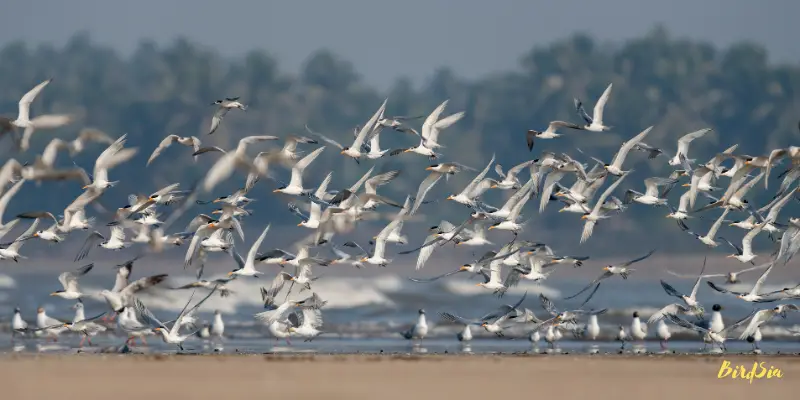
The three species of white-colored birds that migrate to Florida during the winter season are:
- Snow Goose (Anser caerulescens)
- Ross’s Goose (Anser rossii)
- American White Pelican (Pelecanus erythrorhynchos)
These birds migrate south to Florida during the winter months to escape the harsh conditions of their northern breeding grounds. With the impact of climate change, the populations of Snow Geese and Ross’s Geese have increased due to warmer temperatures altering their breeding habitats.
Additionally, the merging of breeding zones has led to increased hybridization between the two species. The American White Pelican, known for its large size and distinctive bill pouch, is another winter visitor to Florida, where it can be seen in wetland habitats and coastal areas.
1. Snow Goose:

- Scientific Name: Anser caerulescens
- Average Weight: 4–5 lb
- Wingspan: 53–65 inches
- Lifespan: 15 years
- Appearance: Medium-sized, black wingtips, thin neck, pink bill.
- Diet: Plant material, leaves, roots, seeds
- Conservation Status: Least concern
- The best time to see them in Florida: December to January
Snow Geese are commonly seen in large groups. They have a medium size with a long, slender neck and a hefty, pink bill with a dark line on it. During the flight, you can notice their black wingtips. Juveniles are typically slightly smaller than adults, which is especially noticeable during the fall season.
They can also appear in dark morphs, known as Blue Geese. Their name comes from their crystal-white plumage. Snow Geese populations have increased significantly in recent years and are found abundantly across the continent.
They often travel in flocks, sometimes numbering in the hundreds of thousands. They feed together in marshes and muddy lands, primarily on tubers and roots.
Snow Geese adapt well to agricultural fields and are frequently found in wetlands, ploughed cornfields, ponds, and lakes during migration season.
2. Ross’s Goose:
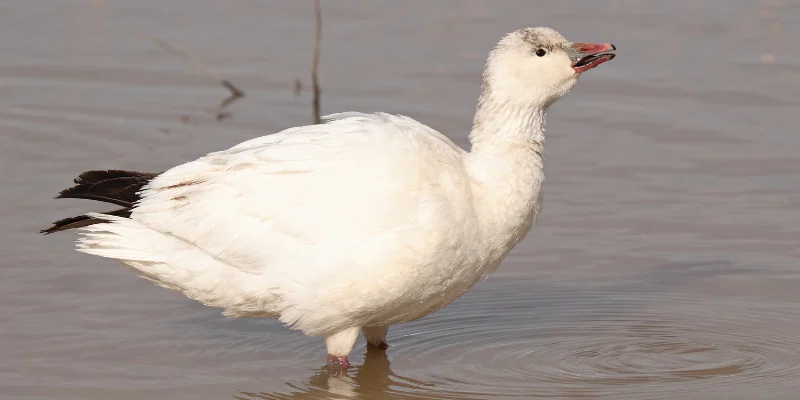
- Scientific Name: Anser rossii
- Average Weight: 2.64 – 2.45 lb
- Wingspan: 45 inches
- Lifespan: 22.5 years
- Appearance: Stocky body, white plumage, short neck, stubby triangular bill, bluish-grey base
- Diet: Primarily grains and grass
- Conservation Status: Least concern
- The best time to see them in Florida: December – January
Ross’s Goose is a smaller version of the Snow Goose, characterized by its white, stocky body, short neck, and triangular bill. Unlike the Snow Goose, it lacks a black-toned grinning patch on its bill. Its head is clean white with a hint of yellowish stain.
Ross’s Geese are herbivores, foraging in wetlands and agricultural fields for vegetation. They nest in dense colonies and share habitat with Snow Geese. After nesting, they become flightless for weeks before migrating south.
3. American White Pelican:

- Scientific Name: Pelecanus erythrorhynchos
- Average Weight: 7.7 – 30 lb
- Wingspan: 95 – 120 inches
- Lifespan: 15 – 25 years
- Appearance: Large-sized, white body, square tails, long head.
- Diet: Fish, crayfish, salamanders
- Conservation Status: Least concern
- The best time to see them in Florida: November – January
The American White Pelican is one of the biggest birds in North America and visits Florida during the winter.
It has a large head and a hefty bill, which makes it look ancient. When it’s in the water, it uses its bill like a scoop to catch fish and other water creatures. During mating season, adults may have yellow feathers on their chests, and their legs may turn orange-yellow.
With wide wings and a thick body, the American White Pelican is amazing to see when it flies. During mating season, adults might have a strange bump on their upper bill. They often gather in groups to hunt fish together in shallow waters along Florida’s coast during the winter.
These pelicans are famous for their flying skills and are among the heaviest birds that can fly long distances with slow, steady wingbeats. You can usually find them in bays, coastal waters, and estuaries.
Final Thought:
In Florida, birdwatchers are treated to a spectacular array of white bird species year-round. From the majestic Great Egret to the graceful Snowy Egret and the vibrant Roseate Spoonbill, these birds adorn the state’s wetlands, coastlines, and marshes with their beauty.
Whether you’re exploring Florida’s pristine beaches or its lush inland habitats, keep an eye out for these elegant creatures. From the striking all-white plumage of the White Ibis to the subtle pink hues of the Roseate Spoonbill, each species adds its own charm to the state’s avian diversity.
And let’s not forget the winter visitors, including Snow Geese, Ross’s Geese, and American White Pelicans, who grace Florida’s shores during the colder months, adding to the excitement of birdwatching in the Sunshine State.
So whether you’re a seasoned birder or just starting, grab your binoculars and head out to discover the beauty of Florida’s stunning white birds. With their diverse habitats and fascinating behaviors, they’re sure to captivate birdwatchers of all ages.
What are the white birds in Florida called?
Egrets, ibis, herons, and pelicans—all of these bird species come in white variations, which can be quite perplexing, especially considering that some of them bear a striking resemblance at first glance.
What is the white bird in Florida that looks like a crane?
The White Ibis (Eudocimus albus) is a small bird found in Florida’s wetlands. It has a bright red face and legs, with a curved bill. During flight, it displays black wingtips, which could be mistaken for the black primaries of the Whooping Crane.
What species of long-billed white bird is commonly found in Florida?
The American White Ibis has a long beak and is found in Florida and coastal areas spanning the southeastern United States, Mexico, Central America, and northern South America. While predominantly resident, some individuals migrate south during the winter.
What is a rare bird in Florida?
The Florida Grasshopper Sparrow, a federally endangered species, is exclusively found in south-central Florida. It resides in dry, open prairies, feeding primarily on seeds and grasshoppers.
Please Write Your Comments